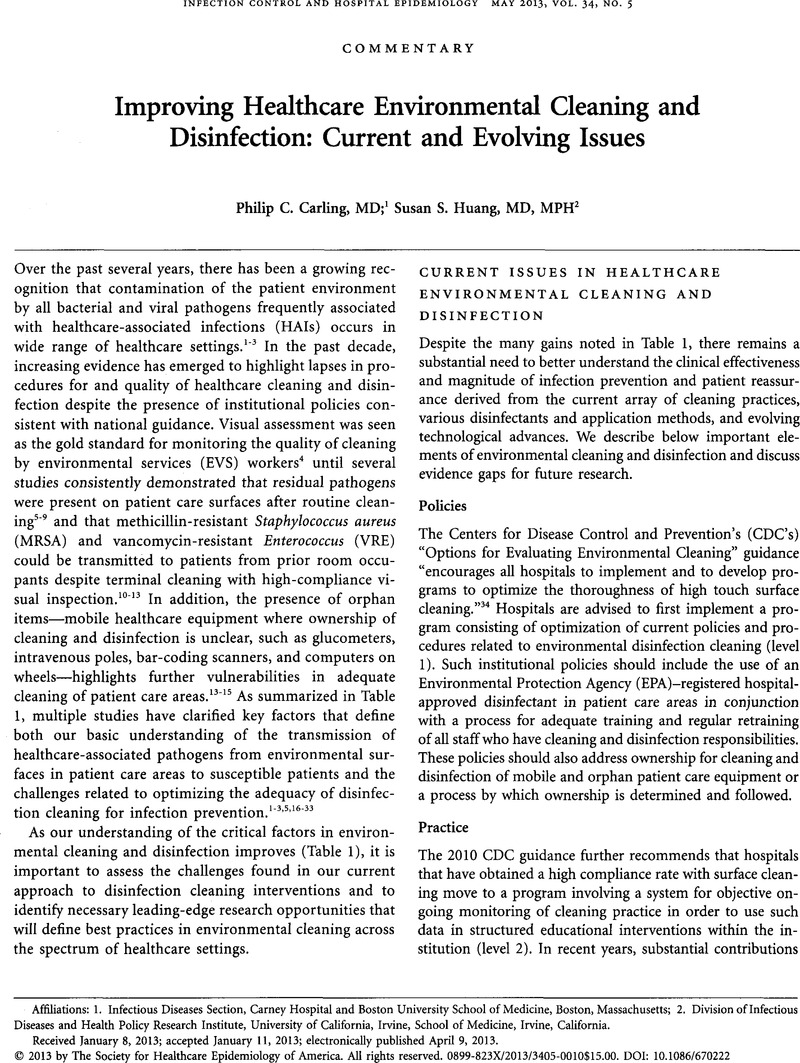Crossref Citations
This article has been cited by the following publications. This list is generated based on data provided by Crossref.
Carling, P.C.
2013.
The need for clinically relevant studies of non-touch disinfecting systems.
Journal of Hospital Infection,
Vol. 84,
Issue. 4,
p.
340.
Weber, David J.
Anderson, Deverick
and
Rutala, William A.
2013.
The role of the surface environment in healthcare-associated infections.
Current Opinion in Infectious Diseases,
Vol. 26,
Issue. 4,
p.
338.
Weber, David J.
and
Rutala, William A.
2013.
Understanding and Preventing Transmission of Healthcare-Associated Pathogens Due to the Contaminated Hospital Environment.
Infection Control & Hospital Epidemiology,
Vol. 34,
Issue. 5,
p.
449.
Cadnum, Jennifer L.
Hurless, Kelly N.
Deshpande, Abhishek
Nerandzic, Michelle M.
Kundrapu, Sirisha
Donskey, Curtis J.
and
Loeffelholz, M. J.
2014.
Sensitive and Selective Culture Medium for Detection of Environmental Clostridium difficile Isolates without Requirement for Anaerobic Culture Conditions.
Journal of Clinical Microbiology,
Vol. 52,
Issue. 9,
p.
3259.
Spruce, Lisa
and
Wood, Amber
2014.
Back to Basics: Environmental Cleaning.
AORN Journal,
Vol. 100,
Issue. 1,
p.
54.
Dancer, Stephanie J.
2014.
Controlling Hospital-Acquired Infection: Focus on the Role of the Environment and New Technologies for Decontamination.
Clinical Microbiology Reviews,
Vol. 27,
Issue. 4,
p.
665.
Pegues, David A.
2014.
Translating and Scaling the HHS Action Plan to Prevent Healthcare-associated Infections to the Local Level.
Medical Care,
Vol. 52,
Issue. Supplement 1,
p.
S60.
Cooper, Tracey
Sjogren, Geoff
Randle, Jacqueline
and
Percival, Steven L
2014.
Biofilms in Infection Prevention and Control.
p.
49.
Saiman, Lisa
Siegel, Jane D.
LiPuma, John J.
Brown, Rebekah F.
Bryson, Elizabeth A.
Chambers, Mary Jo
Downer, Veronica S.
Fliege, Jill
Hazle, Leslie A.
Jain, Manu
Marshall, Bruce C.
O’Malley, Catherine
Pattee, Suzanne R.
Potter-Bynoe, Gail
Reid, Siobhan
Robinson, Karen A.
Sabadosa, Kathryn A.
Schmidt, H. Joel
Tullis, Elizabeth
Webber, Jennifer
and
Weber, David J.
2014.
Infection Prevention and Control Guideline for Cystic Fibrosis: 2013 Update.
Infection Control & Hospital Epidemiology,
Vol. 35,
Issue. S1,
p.
s1.
Reddy, Shravanthi T
2014.
Surface Micropattern Resists Bacterial Contamination Transferred by Healthcare Practitioners.
Journal of Microbiology & Experimentation,
Vol. 1,
Issue. 5,
Knelson, Lauren P.
Williams, David A.
Gergen, Maria F.
Rutala, William A.
Weber, David J.
Sexton, Daniel J.
and
Anderson, Deverick J.
2014.
A Comparison of Environmental Contamination by Patients Infected or Colonized with Methicillin-Resistant Staphylococcus aureus or Vancomycin-Resistant Enterococci: A Multicenter Study.
Infection Control & Hospital Epidemiology,
Vol. 35,
Issue. 7,
p.
872.
Safdar, Nasia
Anderson, Deverick J.
Braun, Barbara I.
Carling, Philip
Cohen, Stuart
Donskey, Curtis
Drees, Marci
Harris, Anthony
Henderson, David K.
Huang, Susan S.
Juthani-Mehta, Manisha
Lautenbach, Ebbing
Linkin, Darren R.
Meddings, Jennifer
Miller, Loren G.
Milstone, Aaron
Morgan, Daniel
Sengupta, Sharmila
Varman, Meera
Yokoe, Deborah
and
Zerr, Danielle M.
2014.
The Evolving Landscape of Healthcare-Associated Infections: Recent Advances in Prevention and a Road Map for Research.
Infection Control & Hospital Epidemiology,
Vol. 35,
Issue. 5,
p.
480.
Chemaly, Roy F.
Simmons, Sarah
Dale, Charles
Ghantoji, Shashank S.
Rodriguez, Maria
Gubb, Julie
Stachowiak, Julie
and
Stibich, Mark
2014.
The role of the healthcare environment in the spread of multidrug-resistant organisms: update on current best practices for containment.
Therapeutic Advances in Infectious Disease,
Vol. 2,
Issue. 3-4,
p.
79.
Carling, Philip C.
Perkins, Jennifer
Ferguson, JoAnn
and
Thomasser, Anita
2014.
Evaluating a New Paradigm for Comparing Surface Disinfection in Clinical Practice.
Infection Control & Hospital Epidemiology,
Vol. 35,
Issue. 11,
p.
1349.
Whiteley, Greg S.
Derry, Chris
Glasbey, Trevor
and
Fahey, Paul
2015.
The Perennial Problem of Variability In Adenosine Triphosphate (ATP) Tests for Hygiene Monitoring Within Healthcare Settings.
Infection Control & Hospital Epidemiology,
Vol. 36,
Issue. 6,
p.
658.
Saito, Rena
Virji, M. Abbas
Henneberger, Paul K.
Humann, Michael J.
LeBouf, Ryan F.
Stanton, Marcia L.
Liang, Xiaoming
and
Stefaniak, Aleksandr B.
2015.
Characterization of cleaning and disinfecting tasks and product use among hospital occupations.
American Journal of Industrial Medicine,
Vol. 58,
Issue. 1,
p.
101.
Livshiz-Riven, Ilana
Borer, Abraham
Nativ, Ronit
Eskira, Seada
and
Larson, Elaine
2015.
Relationship between shared patient care items and healthcare-associated infections: A systematic review.
International Journal of Nursing Studies,
Vol. 52,
Issue. 1,
p.
380.
Napolitano, Nathanael A.
Mahapatra, Tanmay
and
Tang, Weiming
2015.
The effectiveness of UV-C radiation for facility-wide environmental disinfection to reduce health care–acquired infections.
American Journal of Infection Control,
Vol. 43,
Issue. 12,
p.
1342.
Miller, Renee
Simmons, Sarah
Dale, Charles
Stachowiak, Julie
and
Stibich, Mark
2015.
Utilization and impact of a pulsed-xenon ultraviolet room disinfection system and multidisciplinary care team on Clostridium difficile in a long-term acute care facility.
American Journal of Infection Control,
Vol. 43,
Issue. 12,
p.
1350.
Whiteley, Greg S.
Derry, Chris
and
Glasbey, Trevor
2015.
Failure analysis in the identification of synergies between cleaning monitoring methods.
American Journal of Infection Control,
Vol. 43,
Issue. 2,
p.
147.





